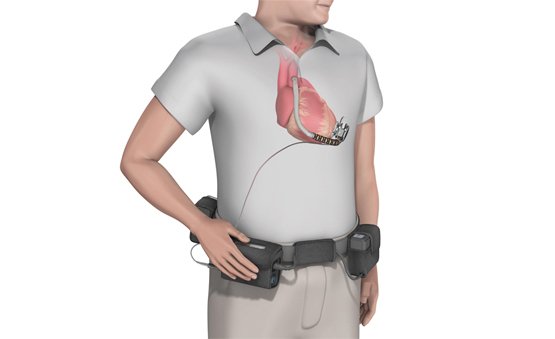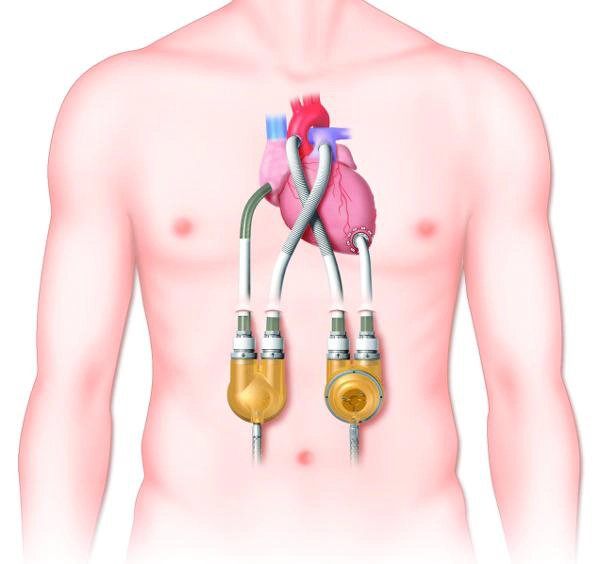Artificial heart

In principle, mechanical support systems can only be used if the heart cannot fulfill its function and cannot be replaced by a donor heart or a donor heart is not available. Different scenarios are presented here, making different types of mechanical circulatory support necessary.
Scenario I
In the context of surgery using a cardiopulmonary bypass machine, immediate recovery of cardiac function is not possible. This means that the patient cannot be kept alive without a cardiopulmonary bypass machine. A support system is needed to enable the completion of such an operation. Depending on whether both ventricles are affected, either only the left ventricle is supported or - in rare cases - the whole heart and lung are bridged. This is achieved with a centrifugal pump system, which allows a blood flow of up to 6 liters per minute. Under certain conditions, an oxygenator can be integrated into the system, which enriches the blood with oxygen.
Such a system is simple and safe. The disadvantage, however, is that use is limited to 7-8 days. As a rule, recovery of cardiac function is achieved during this time, as the heart does not have to work during the extracorporeal circulation and remains unencumbered.
In the case of recovery of cardiac function within the first week, removal of the system can occur without problems, and the further course of recovery of patients does not differ from that of other cardiac patients.
Scenario ΙΙ
This involves using mechanical support systems as a bridge until a graft is available. The decisive factor is whether only the left ventricle or the whole heart should be supported.
These are primarily patients already on the waiting list for a heart transplant and whose condition is deteriorating rapidly. The second group are patients whose heart function has dramatically deteriorated due to infarction or inflammation of the heart muscles and who are at risk of death.
A so-called extracorporeal support system is used in case of functional limitation of both ventricles. Through two air-operated pumping chambers, the ventricular pump function is replaced and/or supported.

If the left ventricular pump function is significantly limited, then a much smaller pump system can be implanted. It is not a pumping chamber but an axial flow pump. The blood is transferred via an Archimedes screw. These devices are tiny and can be fully implanted into the supply line.
With this support system, it naturally becomes easier to mobilize the patient, and it is possible to leave the clinic.
Both support modes serve as a bridge until a donor heart is available. In rare cases, medium-term recovery of cardiac function may occur so that these systems can be successfully removed and the heart can function normally again
Scenario ΙΙΙ
This involves patients whose left ventricular function is significantly limited. For these patients, heart transplantation is unfortunately not an option. They are either contraindicated for transplantation or are of advanced age. In order to help these patients and ensure their quality of life, the above-mentioned axial flow valves are used. This ensures adequate pump function, and patients can leave the clinic with these systems. However, this form of use and indication is only intended for selected patients. Due to the lack of natural alternatives, this use will continue to gain importance in the future.
